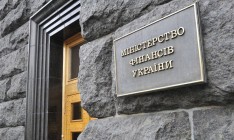Economy
national debtUkraine is viewing the possibility of restructuring its foreign debt

Ukraine’s government is considering the possibility of restructuring part of its external liabilities to private bondholders. The government held informal talks on this issue as was reported at the end of last week by The Wall Street Journal with reference to the Institute of International Finance (IIF). The IIF represents over 450 of the world’s largest banks and hedge funds. The information immediately reflected on the quotations of Ukraine’s bonds. As a result, the rise in the prices of Eurobonds in the middle of the week amid favorable information on staff decisions of the president turned into a decline by the end of the week. The securities maturing in October and September 2015 cheapened the most by 1.109 and 1.076 basis points respectively. The yield on these securities increased to 9.726% and 10.002% per annum.
Investors’ optimism
The objectives of the talks were to explore the possible options as to what type of bond restructuring is possible if Ukraine’s economic crisis worsens, said Lubomir Mitov, a senior economist at the Institute of International Finance. That is the reason that no decisions on conditions of debt restructuring were made, he said. Most likely, the possibility of extending the maturities of Ukraine’s debt was discussed. It is not clear yet whether the Ukrainian government will be forced to ask bondholders to agree to change debt repayment conditions. The question about debt restructuring will become pressing only if Ukraine does not receive its next loan from the International Monetary Fund, believes Vadim Khramov, an economist at Bank of America Merrill Lynch.
The chances of such a scenario, however, are relatively low, he added. The position of Edmond de Rothschild Asset Management in Paris, which owns Ukraine’s short-term bonds, is the same with the fund manager Jean-Jacques Durand saying that “debt restructuring is not a major concern” at the moment. That is why the fund did not rush to sell Ukrainian notes after the statement of the IIF.
Further steps of the government on external debt restructuring may become more meaningful after assessment of the problems of the Ukrainian economy and the decision of the IMF on the terms of the next loan tranches for Ukraine, claims the IIF. The IMF mission starts its work in Kyiv on June 24.
External dependence
The Ministry of Finance of Ukraine did not respond to the inquiry of Capital about the stage of talks on debt restructuring and who the talks were held due to the weekend break. It can be assumed that the issue was discussed with Global Bonds Franklin Templeton Fixed Income Group, the largest holder of Ukraine’s bonds. By the end of 2013, Franklin Templeton owned about US $6 bn of Ukraine’s debt. In July-September 2013 alone the company purchased Ukraine’s bonds for US $1.4 bn. The company owns 21.6% of the external debt of Ukraine. According to the Ministry of Finance, Ukraine’s external debt amounted to US $27.7 bn as of April 30.
In the heat of the conflict in the east of the country and prior to the elections, Franklin Templeton Executive Vice President, CIO, Global Bonds Michael Hasenstab announced that the company will keep its investments in Ukraine, believing in the country’s long-term potential. “Naturally, the mass political unrest incited a negative reaction of investors, which affected market price formation for the Ukrainian assets. However, having assessed the situation in the course of our recent visit to the country, we saw a huge long-term potential. This is why we are investing in Ukraine,” said Hasenstab.
Ukrainian experts admit that the situation with the country’s external debt is not very favorable despite that in January-March Ukraine’s debt fell by 3.3% compared to the first quarter of 2013 to US $137 bn, which is 105% of the GDP forecast for 2014. The decrease in the external foreign debt was mainly due to repayments on the backdrop of the absence of new borrowings (minus US $1.5 bn to US $30 bn) and also a sharp decline of trade loans by US $4 bn (to US $19.7 bn), including due to hryvnia devaluation.
“Taking into account the recent and future government borrowings from official creditors we expect a gradual growth in the gross external debt starting from Q2 and forecast its volume at US $147 bn by the end of 2014 (+3.2% y-o-y) or 118% of the GDP. The expected increase in the debt/GDP ratio compared with 78% at the end of 2013 is mainly due to the sharp reduction of the forecast of nominal GDP in the dollar equivalent to US $130 bn from US $182 bn in 2013 due to hryvnia devaluation, economic recession and the annexation of Crimea,” says Olena Belan, senior economist at Dragon Capital.
Meanwhile, despite the increase in Ukraine’s external debt, there have been no problems with repayment in 2014. The Finance Ministry recently paid a coupon yield on 2013 bonds in the amount of US $73.3 mn. The possible inquiry in the issue of restructuring is likely linked with the year 2015, when large payments are due, believes Oleksandr Zholud, senior analyst at the International Center for Policy Studies. “The government may propose restructuring in order to stretch out the repayments over a longer period. This is possible if the Cabinet of Ministers forecasts that the following years will be a relatively heavy burden on the budget,” he said.







 of the agreement of syndication with Financial Times Limited are strictly prohibited. Use of materials which refers to France-Presse, Reuters, Interfax-Ukraine, Ukrainian News, UNIAN agencies is strictly prohibited. Materials marked
of the agreement of syndication with Financial Times Limited are strictly prohibited. Use of materials which refers to France-Presse, Reuters, Interfax-Ukraine, Ukrainian News, UNIAN agencies is strictly prohibited. Materials marked  are published as advertisements.
are published as advertisements.